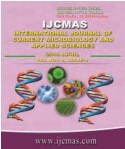


 National Academy of Agricultural Sciences (NAAS)
National Academy of Agricultural Sciences (NAAS)

|
PRINT ISSN : 2319-7692
Online ISSN : 2319-7706 Issues : 12 per year Publisher : Excellent Publishers Email : editorijcmas@gmail.com / submit@ijcmas.com Editor-in-chief: Dr.M.Prakash Index Copernicus ICV 2018: 95.39 NAAS RATING 2020: 5.38 |
The purpose of this study is to quantify the floristic diversity in forests and coffee agroforests and to know the effects of different landholding sizes in Kodagu district of India's the Western Ghats. We collected the data on trees, shrubs and herbs from 50 sample plots of 0.16 ha. each and analyzed for various diversity parameters. Results revealed Shannon’s (H') was highest in coffee agroforests (3.60) compared to that of natural forest (3.32). Conversely, Simpson’s (D) values did not differ between the land-use types. This study revealed that the considerable number of tree species are being managed and conserved in coffee agroforests, similar to that of adjoining natural forests. IVI revealed that Artocarpus integrifolia was found to be dominant in coffee agroforests while in natural forests, Elaeocarpus tuberculatus species was dominant. Considerable variation in various diversity parameters among different landholding sizes with higher diversity in small holding compared to medium and large size coffee farms. Contrary, higher basal area (m2 ha–1) was recorded in large farms compared to small and medium-size farms. We found that coffee agroforests resembled natural forest suggesting that traditional coffee farms are being sustainably managed and can help to conserve the biodiversity of this region.
 |
 |
 |
 |
 |